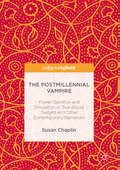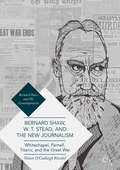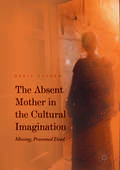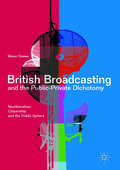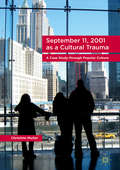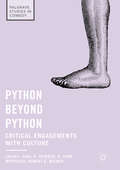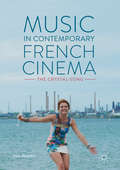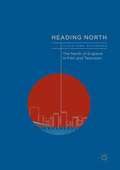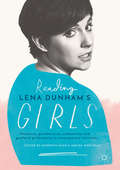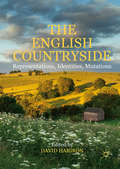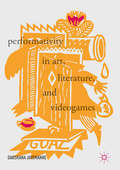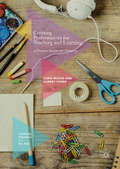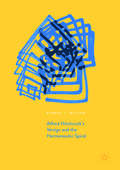- Table View
- List View
The Postmillennial Vampire: Power, Sacrifice and Simulation in True Blood, Twilight and Other Contemporary Narratives
by Susan ChaplinThis book explores the idea that while we see the vampire as a hero of romance, or as a member of an oppressed minority struggling to fit in and acquire legal recognition, the vampire has in many ways changed beyond recognition over recent decades due to radically shifting formations of the sacred in contemporary culture. The figure of the vampire has captured the popular imagination to an unprecedented extent since the turn of the millennium. The philosopher René Girard associates the sacred with a communal violence that sacred ritual controls and contains. As traditional formations of the sacred fragment, the vampire comes to embody and enact this ‘sacred violence’ through complex blood bonds that relate the vampire to the human in wholly new ways in the new millennium.
Bernard Shaw, W. T. Stead, and the New Journalism: Whitechapel, Parnell, Titanic, and the Great War
by Nelson O'Ceallaigh RitschelThis book explores Bernard Shaw’s journalism from the mid-1880s through the Great War—a period in which Shaw contributed some of the most powerful and socially relevant journalism the western world has experienced. In approaching Shaw’s journalism, the promoter and abuser of the New Journalism, W. T. Stead, is contrasted to Shaw, as Shaw countered the sensational news copy Stead and his disciples generated. To understand Shaw’s brand of New Journalism, his responses to the popular press’ portrayals of high profile historical crises are examined, while other examples prompting Shaw’s journalism over the period are cited for depth: the 1888 Whitechapel murders, the 1890-91 O’Shea divorce scandal that fell Charles Stewart Parnell, peace crusades within militarism, the catastrophic Titanic sinking, and the Great War. Through Shaw’s journalism that undermined the popular press’ shock efforts that prevented rational thought, Shaw endeavored to promote clear thinking through the immediacy of his critical journalism. Arguably, Shaw saved the free press.
Bernard Shaw, W. T. Stead, and the New Journalism: Whitechapel, Parnell, Titanic, and the Great War
by Nelson O'Ceallaigh RitschelThis book explores Bernard Shaw’s journalism from the mid-1880s through the Great War—a period in which Shaw contributed some of the most powerful and socially relevant journalism the western world has experienced. In approaching Shaw’s journalism, the promoter and abuser of the New Journalism, W. T. Stead, is contrasted to Shaw, as Shaw countered the sensational news copy Stead and his disciples generated. To understand Shaw’s brand of New Journalism, his responses to the popular press’ portrayals of high profile historical crises are examined, while other examples prompting Shaw’s journalism over the period are cited for depth: the 1888 Whitechapel murders, the 1890-91 O’Shea divorce scandal that fell Charles Stewart Parnell, peace crusades within militarism, the catastrophic Titanic sinking, and the Great War. Through Shaw’s journalism that undermined the popular press’ shock efforts that prevented rational thought, Shaw endeavored to promote clear thinking through the immediacy of his critical journalism. Arguably, Shaw saved the free press.
The Absent Mother in the Cultural Imagination: Missing, Presumed Dead
by Berit ÅströmThis anthology explores the recurring trope of the dead or absent mother in Western cultural productions. Across historical periods and genres, this dialogue has been employed to articulate and debate questions of politics and religion, social and cultural change as well as issues of power and authority within the family. Åström seeks to investigate the many functions and meanings of the dialogue by covering extensive material from the 1200s to 2014 including hagiography, romances, folktales, plays, novels, children’s literature and graphic novels, as well as film and television. This is achieved by looking at the discourse both as products of the time and culture that produced the various narratives, and as part of an on-going cultural conversation that spans the centuries, resulting in an innovative text that will be of great interest to all scholars of gender, feminist and media studies.
The Absent Mother in the Cultural Imagination: Missing, Presumed Dead
by Berit ÅströmThis anthology explores the recurring trope of the dead or absent mother in Western cultural productions. Across historical periods and genres, this dialogue has been employed to articulate and debate questions of politics and religion, social and cultural change as well as issues of power and authority within the family. Åström seeks to investigate the many functions and meanings of the dialogue by covering extensive material from the 1200s to 2014 including hagiography, romances, folktales, plays, novels, children’s literature and graphic novels, as well as film and television. This is achieved by looking at the discourse both as products of the time and culture that produced the various narratives, and as part of an on-going cultural conversation that spans the centuries, resulting in an innovative text that will be of great interest to all scholars of gender, feminist and media studies.
British Broadcasting and the Public-Private Dichotomy: Neoliberalism, Citizenship and the Public Sphere
by Simon DawesThis text offers a theoretical engagement with the ways in which private and public interests - and how those interests have been understood - have framed the changing rationale for broadcasting regulation, using the first century of UK broadcasting as a starting point. Unlike most books on broadcasting, this text adopts an explicitly Foucauldian and genealogical perspective in its account of media history and power, and unpicks how the meanings of terms such as 'public service' and 'public interest', as well as 'competition' and 'choice', have evolved over time. In considering the appropriation by broadcasting scholars of concepts such as neoliberalism, citizenship and the public sphere to a critical account of broadcasting history, the book assesses their appropriateness and efficacy by engaging with interdisciplinary debates on each concept. This work will be of particular significance to academics and students with an interest in media theory, history, policy and regulation, as well as those disposed to understanding as well as critiquing the neoliberalization of public media.
British Broadcasting and the Public-Private Dichotomy: Neoliberalism, Citizenship and the Public Sphere
by Simon DawesThis text offers a theoretical engagement with the ways in which private and public interests - and how those interests have been understood - have framed the changing rationale for broadcasting regulation, using the first century of UK broadcasting as a starting point. Unlike most books on broadcasting, this text adopts an explicitly Foucauldian and genealogical perspective in its account of media history and power, and unpicks how the meanings of terms such as 'public service' and 'public interest', as well as 'competition' and 'choice', have evolved over time. In considering the appropriation by broadcasting scholars of concepts such as neoliberalism, citizenship and the public sphere to a critical account of broadcasting history, the book assesses their appropriateness and efficacy by engaging with interdisciplinary debates on each concept. This work will be of particular significance to academics and students with an interest in media theory, history, policy and regulation, as well as those disposed to understanding as well as critiquing the neoliberalization of public media.
September 11, 2001 as a Cultural Trauma: A Case Study through Popular Culture
by Christine MullerThis book investigates the September 11, 2001 attacks as a case study of cultural trauma, as well as how the use of widely-distributed, easily-accessible forms of popular culture can similarly focalize evaluation of other moments of acute and profoundly troubling historical change. The attacks confounded the traditionally dominant narrative of the American Dream, which has persistently and pervasively featured optimism and belief in a just world that affirms and rewards self-determination. This shattering of a worldview fundamental to mainstream experience and cultural understanding in the United States has manifested as a cultural trauma throughout popular culture in the first decade of the twenty-first century. Popular press oral histories, literary fiction, television, and film are among the multiple, ubiquitous sites evidencing preoccupations with existential crisis, vulnerability, and moral ambivalence, with fate, no-win scenarios, and anti-heroes now pervading commonly-told and readily-accessible stories. Christine Muller examines how popular culture affords sites for culturally-traumatic events to manifest and how readers, viewers, and other audiences negotiate their fallout.
September 11, 2001 as a Cultural Trauma: A Case Study through Popular Culture
by Christine MullerThis book investigates the September 11, 2001 attacks as a case study of cultural trauma, as well as how the use of widely-distributed, easily-accessible forms of popular culture can similarly focalize evaluation of other moments of acute and profoundly troubling historical change. The attacks confounded the traditionally dominant narrative of the American Dream, which has persistently and pervasively featured optimism and belief in a just world that affirms and rewards self-determination. This shattering of a worldview fundamental to mainstream experience and cultural understanding in the United States has manifested as a cultural trauma throughout popular culture in the first decade of the twenty-first century. Popular press oral histories, literary fiction, television, and film are among the multiple, ubiquitous sites evidencing preoccupations with existential crisis, vulnerability, and moral ambivalence, with fate, no-win scenarios, and anti-heroes now pervading commonly-told and readily-accessible stories. Christine Muller examines how popular culture affords sites for culturally-traumatic events to manifest and how readers, viewers, and other audiences negotiate their fallout.
Python beyond Python: Critical Engagements with Culture
by Paul N. Reinsch B. Lynn Whitfield Robert G. WeinerThis collection of original, interdisciplinary essays addresses the work of Monty Python members beyond the comedy show, films, and live performances. These men are prolific creators in a variety of artistic realms beyond the confines of the comedy troupe. Their work as individuals, before and after coming together as Monty Python, demonstrates a restless curiosity about culture that embraces absurdity but seldom becomes cynical. Python members collectively and individually create unique approaches to theatre, film, video games, comic books, business training videos and more. Python Beyond Python increases our understanding of this often neglected work and the meanings of Monty Python.
Python beyond Python: Critical Engagements with Culture
by Paul N. Reinsch B. Lynn Whitfield Robert G. WeinerThis collection of original, interdisciplinary essays addresses the work of Monty Python members beyond the comedy show, films, and live performances. These men are prolific creators in a variety of artistic realms beyond the confines of the comedy troupe. Their work as individuals, before and after coming together as Monty Python, demonstrates a restless curiosity about culture that embraces absurdity but seldom becomes cynical. Python members collectively and individually create unique approaches to theatre, film, video games, comic books, business training videos and more. Python Beyond Python increases our understanding of this often neglected work and the meanings of Monty Python.
Music in Contemporary French Cinema: The Crystal-Song
by Phil PowrieThis book explores composed scores and pre-existing music in French cinema from 1985 to 2015 so as to identify critical musical moments. It shows how heritage films construct space through music, generating what Powrie calls “third space music,” while also working to contain the strong women characters found in French heritage films through the use of leitmotifs and musical cues. He analyses fiction films in which the protagonists perform at the piano, showing how musical performance supports the performance of gender. Building on aspects of musical performance, and in particular the use of songs performed in films, Powrie uses a database of 300 films since 2010 to theorize the intervention of music at critical moments as a “crystal-song”. Applying Roland Barthes’s concept of the “punctum” and Gille Deleuze’s concept of the “crystal-image,” Powrie establishes the importance of the crystal-song, which reconfigures time as a crystallization of past, present and future.
Music in Contemporary French Cinema: The Crystal-Song
by Phil PowrieThis book explores composed scores and pre-existing music in French cinema from 1985 to 2015 so as to identify critical musical moments. It shows how heritage films construct space through music, generating what Powrie calls “third space music,” while also working to contain the strong women characters found in French heritage films through the use of leitmotifs and musical cues. He analyses fiction films in which the protagonists perform at the piano, showing how musical performance supports the performance of gender. Building on aspects of musical performance, and in particular the use of songs performed in films, Powrie uses a database of 300 films since 2010 to theorize the intervention of music at critical moments as a “crystal-song”. Applying Roland Barthes’s concept of the “punctum” and Gille Deleuze’s concept of the “crystal-image,” Powrie establishes the importance of the crystal-song, which reconfigures time as a crystallization of past, present and future.
Heading North: The North of England in Film and Television
by Ewa MazierskaThis collection presents a number of films and television programmes set in the North of England in an investigation of how northern identity imbricates with class, race, gender, rural and urban identities. Heading North considers famous screen images of the North, such as Coronation Street and Kes (1969), but the main purpose is to examine its lesser known facets. From Mitchell and Kenyon’s ‘Factory Gate’ films to recent horror series In the Flesh, the authors analyse how the dominant narrative of the North of England as an ‘oppressed region’ subordinated to the economically and politically powerful South of England is challenged. The book discusses the relationship between the North of England and the rest of the world and should be of interest to students of British cinema and television, as well as to those broadly interested in its history and culture.
Heading North: The North of England in Film and Television
by Ewa MazierskaThis collection presents a number of films and television programmes set in the North of England in an investigation of how northern identity imbricates with class, race, gender, rural and urban identities. Heading North considers famous screen images of the North, such as Coronation Street and Kes (1969), but the main purpose is to examine its lesser known facets. From Mitchell and Kenyon’s ‘Factory Gate’ films to recent horror series In the Flesh, the authors analyse how the dominant narrative of the North of England as an ‘oppressed region’ subordinated to the economically and politically powerful South of England is challenged. The book discusses the relationship between the North of England and the rest of the world and should be of interest to students of British cinema and television, as well as to those broadly interested in its history and culture.
Reading Lena Dunham’s Girls: Feminism, postfeminism, authenticity and gendered performance in contemporary television
by Meredith Nash Imelda WhelehanIn this book, leading and emerging scholars consider the mixed critical responses to Lena Dunham’s TV series Girls and reflect on its significance to contemporary debates about postfeminist popular cultures in a post-recession context. The series features both familiar and innovative depictions of young women and men in contemporary America that invite comparisons with Sex and the City. It aims for a refreshed, authentic expression of postfeminist femininity that eschews the glamour and aspirational fantasies spawned by its predecessor. This volume reviews the contemporary scholarship on Girls, from its representation of post-millennial gender politics to depictions of the messiness and imperfections of sex, embodiment, and social interactions. Topics covered include Dunham’s privileged role as author/auteur/actor, sexuality, body consciousness, millennial gender identities, the politics of representation, neoliberalism, and post-recession society. This book provides diverse and provocative critical responses to the show and to wider social and media contexts, and contributes to a new generation of feminist scholarship with a powerful concluding reflection from Rosalind Gill. It will appeal to those interested in feminist theory, identity politics, popular culture, and media.
Reading Lena Dunham’s Girls: Feminism, postfeminism, authenticity and gendered performance in contemporary television
by Meredith Nash Imelda WhelehanIn this book, leading and emerging scholars consider the mixed critical responses to Lena Dunham’s TV series Girls and reflect on its significance to contemporary debates about postfeminist popular cultures in a post-recession context. The series features both familiar and innovative depictions of young women and men in contemporary America that invite comparisons with Sex and the City. It aims for a refreshed, authentic expression of postfeminist femininity that eschews the glamour and aspirational fantasies spawned by its predecessor. This volume reviews the contemporary scholarship on Girls, from its representation of post-millennial gender politics to depictions of the messiness and imperfections of sex, embodiment, and social interactions. Topics covered include Dunham’s privileged role as author/auteur/actor, sexuality, body consciousness, millennial gender identities, the politics of representation, neoliberalism, and post-recession society. This book provides diverse and provocative critical responses to the show and to wider social and media contexts, and contributes to a new generation of feminist scholarship with a powerful concluding reflection from Rosalind Gill. It will appeal to those interested in feminist theory, identity politics, popular culture, and media.
The English Countryside: Representations, Identities, Mutations
by David HaigronThis collection of essays examines representations of the English countryside and its mutations, and what they reveal about a nation’s, communities’ or individuals’ search for identity – and fear of losing it. Based on a pluridisciplinary approach and a variety of media, this book challenges the view that the English countryside is an apolitical space characterised by permanence and lack of conflict. It analyses how the pastoral motif is actually subverted to explore liminal spaces and temporalities. The authors deconstruct the “rural idyll” myth to show how it plays a distinctive and yet ambiguous part in defining Englishness/Britishness. A must read for both scholars and students interested in British rural and cultural history, media and literature.
The English Countryside: Representations, Identities, Mutations
by David HaigronThis collection of essays examines representations of the English countryside and its mutations, and what they reveal about a nation’s, communities’ or individuals’ search for identity – and fear of losing it. Based on a pluridisciplinary approach and a variety of media, this book challenges the view that the English countryside is an apolitical space characterised by permanence and lack of conflict. It analyses how the pastoral motif is actually subverted to explore liminal spaces and temporalities. The authors deconstruct the “rural idyll” myth to show how it plays a distinctive and yet ambiguous part in defining Englishness/Britishness. A must read for both scholars and students interested in British rural and cultural history, media and literature.
Performativity in Art, Literature, and Videogames
by Darshana JayemanneThis book modifies the concept of performativity with media theory in order to build a rigorous method for analyzing videogame performances. Beginning with an interdisciplinary exploration of performative motifs in Western art and literary history, the book shows the importance of framing devices in orienting audiences’ experience of art. The frame, as a site of paradox, links the book’s discussion of theory with close readings of texts, which include artworks, books and videogames. The resulting method is interdisciplinary in scope and will be of use to researchers interested in the performative aspects of gaming, art, digital storytelling and nonlinear narrative.
Performativity in Art, Literature, and Videogames
by Darshana JayemanneThis book modifies the concept of performativity with media theory in order to build a rigorous method for analyzing videogame performances. Beginning with an interdisciplinary exploration of performative motifs in Western art and literary history, the book shows the importance of framing devices in orienting audiences’ experience of art. The frame, as a site of paradox, links the book’s discussion of theory with close readings of texts, which include artworks, books and videogames. The resulting method is interdisciplinary in scope and will be of use to researchers interested in the performative aspects of gaming, art, digital storytelling and nonlinear narrative.
Creating Performances for Teaching and Learning: A Practice Session for Pedagogy
by Chris Mcrae Aubrey HuberThis book uses the metaphors of practice spaces and practice sessions to demonstrate the connection between creative and performance practices, and critical pedagogy. It offers a conceptual framework for using performance and creative practices as starting points for developing philosophies and practices of teaching that are grounded in aesthetic, creative, and critical approaches to education. The practice sessions for pedagogy presented include a range of creative endeavours, such as performance workshops, musical routines, crafting practices, and writing. By focusing on the critical function of creative practices, the book emphasizes the ways creativity can reveal the relationship between everyday acts, and social and cultural ideologies and structures. Creative practices also present the opportunity for imagining new, more socially just and inclusive, configurations of these relationships. This book is designed for teachers and students interested in critical pedagogy, performance, and creative educational practices.
Creating Performances for Teaching and Learning: A Practice Session for Pedagogy (PDF)
by Chris Mcrae Aubrey HuberThis book uses the metaphors of practice spaces and practice sessions to demonstrate the connection between creative and performance practices, and critical pedagogy. It offers a conceptual framework for using performance and creative practices as starting points for developing philosophies and practices of teaching that are grounded in aesthetic, creative, and critical approaches to education. The practice sessions for pedagogy presented include a range of creative endeavours, such as performance workshops, musical routines, crafting practices, and writing. By focusing on the critical function of creative practices, the book emphasizes the ways creativity can reveal the relationship between everyday acts, and social and cultural ideologies and structures. Creative practices also present the opportunity for imagining new, more socially just and inclusive, configurations of these relationships. This book is designed for teachers and students interested in critical pedagogy, performance, and creative educational practices.
Alfred Hitchcock's Vertigo and the Hermeneutic Spiral
by Robert J. BeltonThis book offers a new approach to film studies by showing how our brains use our interpretations of various other films in order to understand Alfred Hitchcock’s Vertigo. Borrowing from behavioral psychology, cognitive science and philosophy, author Robert J. Belton seeks to explain differences of critical opinion as inevitable. The book begins by introducing the hermeneutic spiral, a cognitive processing model that categorizes responses to Vertigo’s meaning, ranging from wide consensus to wild speculations of critical “outliers.” Belton then provides an overview of the film, arguing that different interpreters literally see and attend to different things. The fourth chapter builds on this conclusion, arguing that because people see different things, one can force the production of new meanings by deliberately drawing attention to unusual comparisons. The latter chapters outline a number of such comparisons—including avant-garde films and the works of Stanley Kubrick and David Lynch—to shed new light on the meanings of Vertigo.
Alfred Hitchcock's Vertigo and the Hermeneutic Spiral
by Robert J. BeltonThis book offers a new approach to film studies by showing how our brains use our interpretations of various other films in order to understand Alfred Hitchcock’s Vertigo. Borrowing from behavioral psychology, cognitive science and philosophy, author Robert J. Belton seeks to explain differences of critical opinion as inevitable. The book begins by introducing the hermeneutic spiral, a cognitive processing model that categorizes responses to Vertigo’s meaning, ranging from wide consensus to wild speculations of critical “outliers.” Belton then provides an overview of the film, arguing that different interpreters literally see and attend to different things. The fourth chapter builds on this conclusion, arguing that because people see different things, one can force the production of new meanings by deliberately drawing attention to unusual comparisons. The latter chapters outline a number of such comparisons—including avant-garde films and the works of Stanley Kubrick and David Lynch—to shed new light on the meanings of Vertigo.
